AMD's Radeon HD 6990: The New Single Card King
by Ryan Smith on March 8, 2011 12:01 AM EST- Posted in
- AMD
- Radeon HD 6990
- GPUs
Power, Temperature, and Noise: How Loud Can One Card Get?
Last but not least as always is our look at the power consumption, temperatures, and acoustics of the Radeon HD 6990 series. This is an area where AMD has traditionally had an advantage, as their small die strategy leads to less power hungry and cooler products compared to their direct NVIDIA counterparts. Dual-GPU cards like the 6990 tend to increase the benefits of lower power consumption, but heat and noise are always a wildcard.
AMD continues to use a single reference voltage for their cards, so the voltages we see here represent what we’ll see for all reference 6900 series cards. In this case voltage also plays a big part, as PowerTune’s TDP profile is calibrated around a specific voltage.
| Radeon HD 6900 Series Voltage | ||||
| 6900 Series Idle | 6970 Load | 6990 Load | ||
| 0.9v | 1.175v | 1.12v | ||
The 6990 idles at the same 0.9v as the rest of the 6900 series. At load under default clocks it runs at 1.12v thanks to AMD’s chip binning, and is a big part of why the card uses as little power as it does for its performance. Overclocked to 880MHz however and we see the core voltage go to 1.175v, the same as the 6970. Power consumption and heat generation will shoot up accordingly, exacerbated by the fact that PowerTune is not in use here.

The 6990’s idle power is consistent with the rest of the 6900 series. At 171W it’s at parity with the 6970CF, while we see the advantage of the 6990’s lower idle TDP versus the 5970 in the form of a 9W advantage over the 5970.
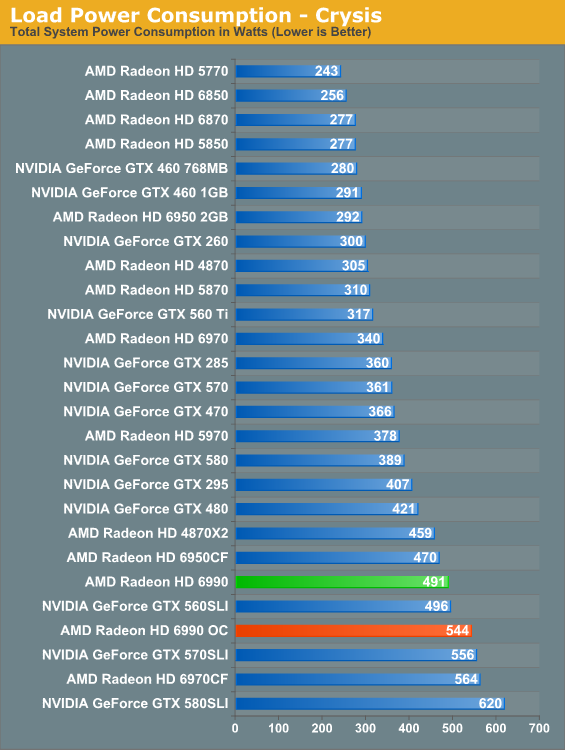
With the 6990, load power under Crysis gives us our first indication that TDP alone can’t be used to predict total power consumption. With a 375W TDP the 6990 should consume less power than 2x200W 6950CF, but in practice the 6950CF setup consumes 21W less. Part of this comes down to the greater CPU load the 6990 can create by allowing for higher framerates, but this doesn’t completely explain the disparity. Compared to the 5970 the 6990 is also much higher than the TDP alone would indicate; the gap of 113W exceeds the 75W TDP difference. Clearly the 6990 truly is a more power hungry card than the 5970.
Meanwhile overclocking does send the power consumption further up, this time to 544W. This is better than the 6970CF at the cost of some performance. Do keep in mind though that at this point we’re dissipating 400W+ off of a single card, which will have repercussions.
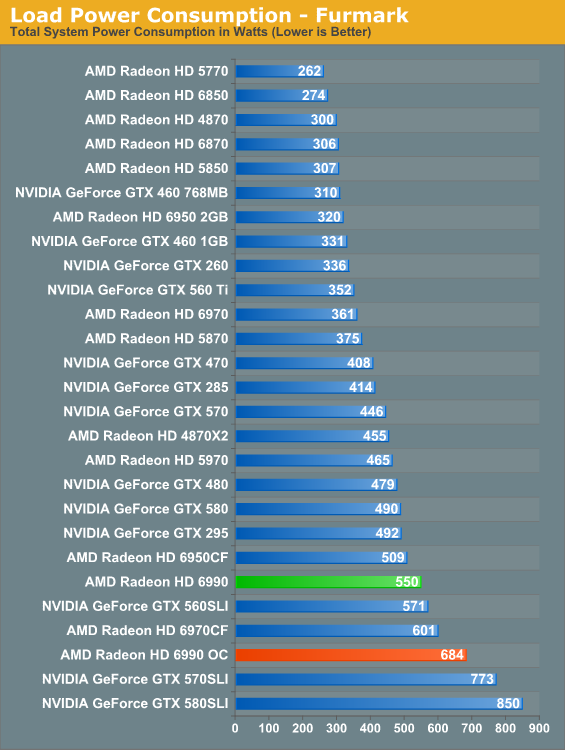
Under FurMark PowerTune limits become the defining factor for the 6900 series. Even with PT triggering on all three 6900 cards, the numbers have the 375W 6990 drawing more than the 2x200W 6950CF, this time by 41W, with the 6970CF in turn drawing 51W more. All things considered the 6990’s power consumption is in line with its performance relative to the other 6900 series cards.
As for our 6990OC, overclocked and without PowerTune we see what the 6990 is really capable of in terms of power consumption and heat. 684W is well above the 6970CF (which has PT intact), and is approaching the 570/580 in SLI. We don’t have the ability to measure the power consumption of solely the video card, but based on our data we’re confident the 6990 is pulling at least 500W – and this is one card with one fan dissipating all of that heat. Front and rear case ventilation starts looking really good at this point.
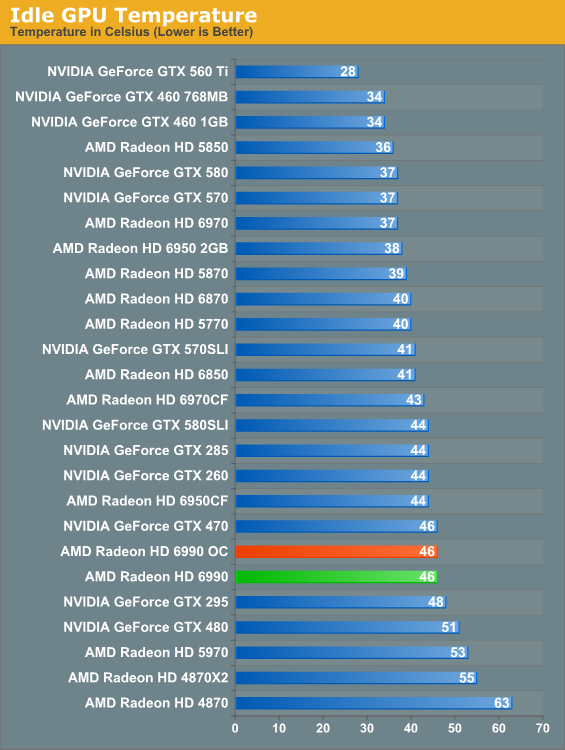
Along with the 6900 series’ improved idle TDP, AMD’s dual-exhaust cooler makes its mark on idle temperatures versus the 5970. At 46C the 6990 is warmer than our average card but not excessively so, and in the meantime it’s 7C cooler than the 5970 which has to contend with GPU2 being cooled with already heated air. A pair of 6900 cards in CF though is still going to beat the dual-exhaust cooler.

When the 5970 came out it was warmer than the 5870CF; the 6990 reverses this trend. At stock clocks the 6990 is a small but measurable 2C cooler than the 6970CF, which as a reminder we run in a “bad” CF configuration by having the cards directly next to each other. There is a noise tradeoff to discuss, but as far as temperatures are concerned these are perfectly reasonable. Even the 6990OC is only 2C warmer.
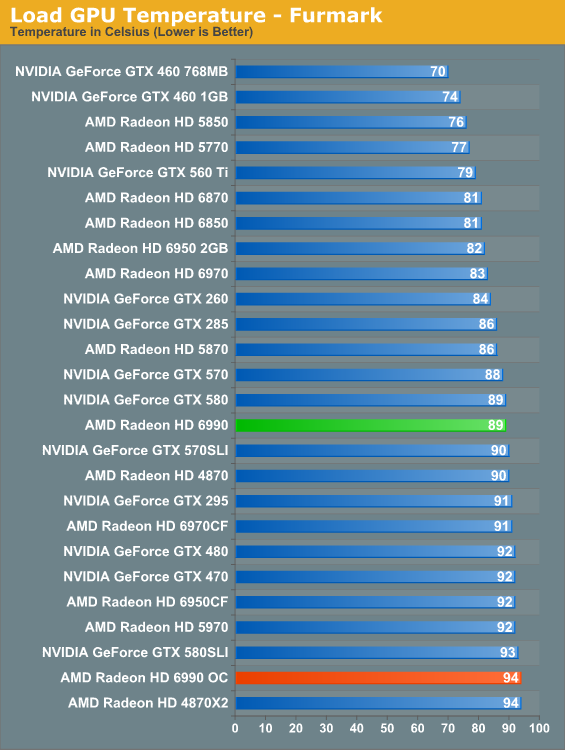
At stock clocks FurMark does not significantly change the picture. If anything it slightly improves things as PowerTune helps to keep the 6990 in the middle of the pack. Overclock however and the story changes. Without PowerTune to keep power consumption in check that 681W power consumption catches up to us in the form of 94C core temperatures. It’s only a 5C difference, but it’s as hot as we’re willing to let the 6990 get. Further overclocking on our test bed is out of the question.
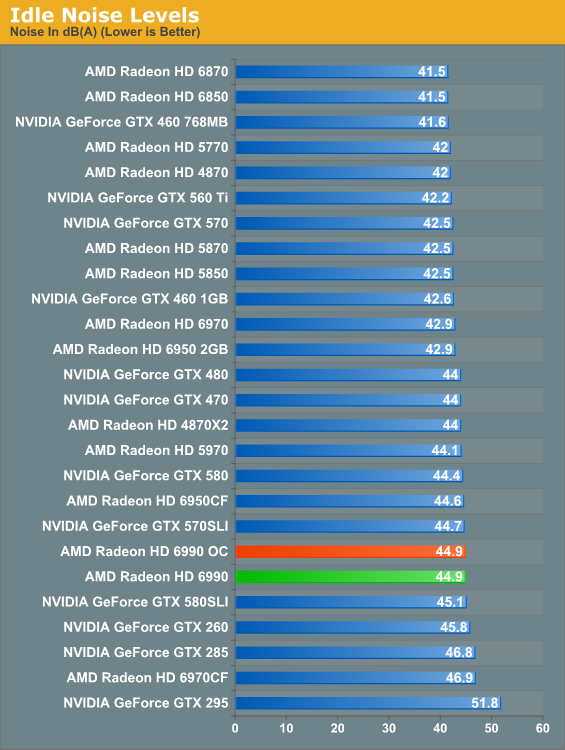
Finally there’s the matter of noise to contend with. At idle nothing is particularly surprising; the 6990 is an iota louder than the average card, presumably due to the dual-exhaust cooler.
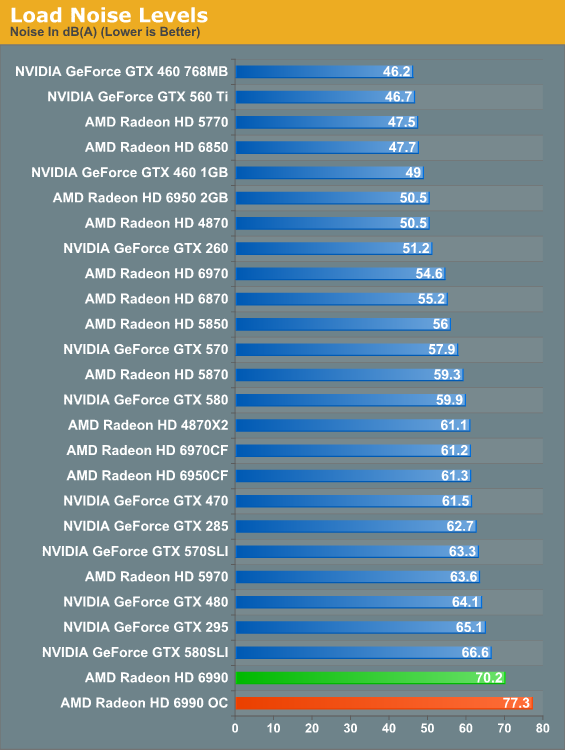
And here’s where it all catches up to us. The Radeon HD 5970 was a loud card, the GTX 580 SLI was even louder, but nothing tops the 6990. The laws of physics are a cruel master, and at some point all the smart engineering in the world won’t completely compensate for the fact that you need a lot of airflow to dissipate 375W of heat. There’s no way around the fact that the 6990 is an extremely loud card; and while games aren’t as bad as FurMark here, it’s still noticeably louder than everything else on a relative basis. Ideally the 6990 requires good airflow and good noise isolation, but the former makes the latter difficult to achieve. Water cooled 6990s will be worth their weight in gold.










130 Comments
View All Comments
nafhan - Tuesday, March 8, 2011 - link
I generally buy cards in the $100-$200 range. Power usage has gone up a bit while performance has increased exponentially over the last 10 years.LtGoonRush - Tuesday, March 8, 2011 - link
I'm disappointed at the choices AMD made with the cooler. The noise levels are truly intolerable, it seems like it would have made more sense to go with a triple-slot card that would be more capable of handling the heat without painful levels of noise. It'll be interesting to see how the aftermarket cooler vendors like Arctic Cooling and Thermalright handle this.Ryan Smith - Tuesday, March 8, 2011 - link
There's actually a good reason for that. I don't believe I mentioned this in the article, but AMD is STRONGLY suggesting not to put a card next to the 6990. It moves so much air that another card blocking its airflow would run the significant risk of killing it.What does this have to do with triple-slot coolers? By leaving a space open, it's already taking up 3 spaces. If the cooler itself takes up 3 spaces, those 3 spaces + 1 open space is now 4 spaces. You'd be hard pressed to find a suitable ATX board and case that could house a pair of these cards in Crossfire if you needed 8 open spaces. Triple slot coolers are effectively the kryptonite for SLI/CF, which is why NVIDIA isn't in favor of them either (but that's a story for another time).
arkcom - Tuesday, March 8, 2011 - link
2.5 slot cooler. That would guarantee at least half a slot is left for airspace.Quidam67 - Tuesday, March 8, 2011 - link
if it means a quieter card then that might have been a compromise worth making. Also, 2.5 would stop people from making the il-advised choice of using the slot next to the card, thus possibly killing it!strikeback03 - Tuesday, March 8, 2011 - link
With the height of a triple slot card maybe they could mount the fan on an angle to prevent blocking it off.kilkennycat - Tuesday, March 8, 2011 - link
Triple-slot coolers... no need!!However, if one is even contemplating Crossfire or SLI then a triple-slot space between the PCIe X16 SOCKETS for a pair of high-power 2-slot-cooler graphics cards with "open-fan" cooling (like the 6990) is recommended to avoid one card being fried by lack of air. This socket-spacing allows a one-slot clear air-space for the "rear" card's intake fan to "breathe". (Obviously, one must not plug any other card into any motherboard socket present in this slot)
In the case of a pair of 6990 (or a pair of nVidia's upcoming dual-GPU card), a minimum one-slot air-space between cards becomes MANDATORY, unless custom water or cryo cooling is installed.
Very few current Crossfire/SLI-compatible motherboards have triple-slot (or more) spaces between the two PCIe X16 connectors while simultaneously also having genuine X16 data-paths to both connectors. That socket spacing is becoming more common with high-end Sandy-Bridge motherboards, but functionality may still may be constrained by X8 PCIe data-paths at the primary pair of X16 connectors.
To even attempt to satisfy the data demands of a pair of 6990 Cross-Fire with a SINGLE physical CPU, you really do need a X58 motherboard and a Gulftown Corei7 990x processor, or maybe a Corei7 970 heavily overclocked. For X58 motherboards with triple-spaced PCIe sockets properly suitable for Crossfire or SLI , you need to look at the Asrock X58 "Extreme" series of motherboards. These do indeed allow full X16 data-paths to the two primary PCIe X16 "triple-spaced" sockets.
Many ATX motherboards have a third "so-called" PCIe X16 socket in the "slot7" position. However, this slot is always incapable of a genuine X16 pairing with either of the other two "X16" sockets, Anyway this "slot 7" location will not allow any more than a two-slot wide card when the motherboard is installed in a PC "tower" -- an open-fan graphics card will have no proper ventilation here, as it comes right up against either the power-supply (if bottom-loaded) or the bottom-plate of the case.
Spazweasel - Tuesday, March 8, 2011 - link
Exactly. For people who are going to do quad-Crossfire with these, you pretty much have to add the cost of a liquid cooling system to the price of the cards, and it's going to have to be a pretty studly liquid cooler too. Of course, the kind of person who "needs" (funny, using that word!) two of these is also probably the kind of person who would do the work to implement a liquid cooling system, so that may be less of an issue than it otherwise might be.So, here's the question (more rhetorical than anything else). For a given ultra-high-end gaming goal, say, Crysis @ max settings, 60fps @ 3x 2500x1600 monitors (something that would require quad Crossfire 69xx or 3-way SLI 580), with a targeted max temperature and noise level... which is the cheaper solution by the time you take into account cooling, case, high-end motherboard, the cards themselves? That's the cost-comparison that needs to be made, not just the cost of the cards themselves.
tzhu07 - Tuesday, March 8, 2011 - link
Before anyone thinks of buying this card stock, you should really go out and get a sense of what that kind of noise level is like. Unless you have a pair of high quality expensive noise-cancelling earbuds and you're playing games at a loud volume, you're going to constantly hear the fan.$700 isn't the real price. Add on some aftermarket cooling and that's how much you're going to spend.
Don't wake the neighbors...
Spivonious - Tuesday, March 8, 2011 - link
70dB is the maximum volume before risk of hearing loss, according to the EPA. http://www.epa.gov/history/topics/noise/01.htmSeriously, AMD, it's time to look at getting more performance per Watt.